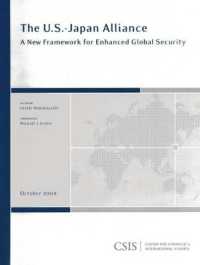- ホーム
- > 洋書
- > 英文書
- > History / World
Full Description
How abolitionists persuaded people of their personal complicity with slavery to advance the cause of freedom
Grievous Entanglement explores the most common way that people in the Atlantic world came to understand their personal connection to, and complicity with, slavery in the late eighteenth and nineteenth centuries: consumption. Consumption became a formidable trope that tied the evils of chattel slavery to individuals' behavior through their purchase of slave-produced commodities like cotton or sugar. With her groundbreaking analysis of this dominant conceptual framework, Erin Pearson provides new insight into both the motivation behind and the functioning of antislavery activism.
Unlike sentimental literature, which sought to engender sympathy for the enslaved, consumption-as-connection leveraged aversion to inspire people to sever their ties with an evil institution. Strategic disgust, Pearson shows, proved effective in inciting abolitionist action. It also frequently slipped into nonabolitionist and even proslavery uses by actually fomenting racism, as this book is the first to demonstrate. Examining a wide variety of media, including poetry, political cartoons, blackface minstrelsy, slave narratives, and novels produced from the late eighteenth to mid-nineteenth centuries, this ingeniously interdisciplinary study reveals how aversive consumption powerfully shaped ideas about slavery to both positive and pernicious effect.







